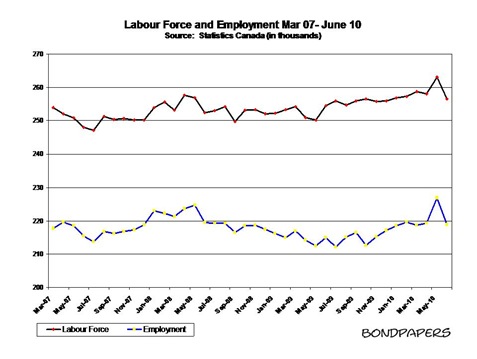From a
cbc.ca/nl story posted on Wednesday June 30, here’s natural resources minister and deputy premier Kathy Dunderdale after the people of the province learned that a company she said had been interested in the Grand Falls-Windsor mill was insolvent and after the investor backed away from the deal:
Dunderdale said she was aware of the company's troubled financial past.
"We knew that there were financial issues, but we knew that their investment wasn't coming from Lott Paper," said Dunderdale.
But here’s what Dunderdale said about the troubled financial past of the company before Saturday, June 26 when Bond Papers posted the news that the company Dunderdale identified as the interested party was insolvent yet again:
Speaking with reporters outside the legislature on June 24, Dunderdale was unequivocal about the name of the company:
The minister revealed that the company, later identified as Lott Paper, is in the process of submitting a business plan. [The Advertiser]
or…
Responding to questions in the legislature, Dunderdale said Lott Paper is working with the government in hopes of acquiring the Grand Falls-Windsor mill that closed in February 2009. [CBC version]
None of this gets better in her scrum on June 30. During the scrum [posted to cbc.ca/nl] Dunderdale claims that the individual who visited the Grand Falls-Windsor mill site explained to her that the investment would be coming from Motion Invest. So why then did she claim it was from Lott when she ought to have clearly known the difference, that is if she’d actually met the chap, had his business card and understood clearly in may who was putting up the cash?
She was also pretty clear about what the company did on May 26:
"It's a pulp and paper company that sees some opportunity because Abitibi is withdrawing from its markets in Europe," Dunderdale later told reporters.
"It's a very credible company, but it's very early days."
And as for the caution Dunderdale now claims she had all along – the “reservation” to use her own word - let’s just say that Calamity Kathy has a very short memory.
On May 25, New Democratic Party leader Lorraine Michael asked a simple question:
Since that is so important - I agree it is - I am asking the Premier: Are they out looking for that major industrial customer to make that happen [to drive industrial development in central Newfoundland]? That is the question I am asking.
Dunderdale did not reply with a general answer that the government was actively seeking expressions of interest, would continue to do so and would announce anything when there was concrete news to report.
No.
She did not do that.
Instead
she said:
While we have not had the results that we are looking for particularly from that Expression of Interest, Mr. Speaker; I am happy to say that we have had an Expression of Interest from Germany last week, principals in, looking at what we have to offer in Central Newfoundland. We are very hopeful about that prospect, Mr. Speaker.
We are very hopeful about that prospect, Mr. Speaker.
She avoided a general answer that would have certainly prevented anyone from having any false expectations or hopes. She decided not to give a non-committal answer, one that would be prudent given that - as any experienced negotiator knows – there is a long way between the first contact and the final deal.
Instead, she said the government had an expression of interest and that “we” – the provincial government – were full of hope about it.
Not cautiously optimistic.
Not wary.
Not concerned, lest people get too excited too early.
Hopeful.
Her caution, such as it was in both May and a month later, seemed to be more about ensuring the public didn’t expect something to happen very suddenly. Her claim on Wednesday that she had reservations all along just isn’t backed up by her own public statements.
Dunderdale only developed any serious reservations about the company once Bond Papers and others revealed the financial problems with the company. And if those concerns weren’t enough, CBC did a fine job of digging out greater detail on the potential investors themselves. All this information was readily available to anyone doing some fairly simple checks. it isn’t rocket science.
All of this checking ought to have been done from the outset. Instead, if one listens to Dunderdale’s scrum from Wednesday, it is clear that neither she nor her staff did anything to check into the company. Dunderdale states at one point well into the questioning that her staff would only do the necessary analysis -doing “due diligence” as Dunderdale puts it in her cliche-ridden way of speaking – once the company sent along a detailed business plan.
Nor is all of this confusion on Dunderdale’s part the only sort of problems there are with this most recent of her cock-ups. Take a good listen to the scrum. What she claimed on June 24 was a letter of intent with a great amount of detail has morphed – now that the problems with the company are in public – into something that wasn’t sufficiently detailed enough for anyone to make a decision on. On June 24 she described the letter – now with insufficient information – as being a business plan.
All of this goes back to an episode much like the current one. It dates from the days when Dunderdale was in charge of the business development portfolio. Then as now, Dunderdale was long on meaningless jargon - “due diligence piece” and very short on either comprehension or details.
As Bond Papers put it in 2005:
She also said this information turned up by reporters wouldn't have "negatively impacted" on government's decision, had it been known.
The problem, Kath is not that you might have acted differently if you knew. The point is you just didn't have all relevant information in front of you when you opened my chequebook to hand some American company some of my cash.
The problem is that we out here among the toiling masses don't know what else it is that you don't know before you make a decision.
Five years later and with considerably more public money up for grabs here, Kathy Dunderdale’s old problem – making decisions without having adequate information – remains the same. So too does her apparent inability to understand what it is that she actually does have in the first place.
Dunderdale has considerably more power now than she did in 2005.
The public still cannot be assured, however, of what she doesn’t know – or care to know – before she’s prepared to carry forward with a project involving potentially tens of millions of dollars of public money.
This is no way to run a provincial government and it is astonishing that the Premier, as capable a businessman as he supposedly is, would allow this situation to continue for five years.
-srbp-
Addendum: From an exchange in the comments section, here are a string of questions coming out of this latest fiasco that need answers.
The answers are important not merely to get to the bottom of this particular episode; they are important because the public should be assured of exactly what the provincial government policy is on using public money to subsidize private businesses. The answers are important because they can give the public some assurance that those in charge of handing out public cash are capable of doing the job of protecting the public interest they get paid to do.
1. If Dunderdale knew the difference between Lott and Motion Invest, when did she know it?
2. Was it before or after she claimed that Lott was the company that would be investing?
3. If she had concerns about the company's financial state, did she have them before or after Lott's bankrupt status was made public (not by Dunderdale)?
4. If she had any doubts at all about this company and its interest, then why did she even mention the whole affair on May 25 and therefore set up the circumstance on June 24 [in which she was asked a follow-on question]?
5. Since she is a cabinet minister with knowledge (presumably), why does she elect to blame someone for merely asking a question?
6. Is the whole thing on or off? According to her comments in the scrum, it's only nearly almost dead. According to the excellent reporting at [the Telegram], the deal is dead.
7. Therefore, what exactly did she say to Roche and what did he say to her in their telephone conversations on Wednesday that could lead to two diametrically opposed comments? [Update: According to Dunderdale in the scrum, she never spoke to Roche: her unidentified CEO did. That raises another question: which CEO was it - Ed Martin or the agrifoods boss? This sort of thing should be going through Ross Wiseman’s department.]
8. And since we are asking, why did she make several calls on Wednesday given that she basically pissed all over the company and their proposal publicly the night before?
9. What is the difference between a letter of intent and a business plan?'
10. Did Kathy actually read the letter from Roche (or whoever sent it)?
11. Will the government pour cash and other subsidies into any venture or will they stand by her earlier comment that there was no cash available?
12. If there is no cash, why didn't she just tell Roche that $52 million was nonsense instead of considering the proposal?
13. If there is cash, then how much is government willing to pour into a venture?
14. Would the government cash be in an equity stake or would it be - as with others - basically like a set of free steak knives for playing the game?




